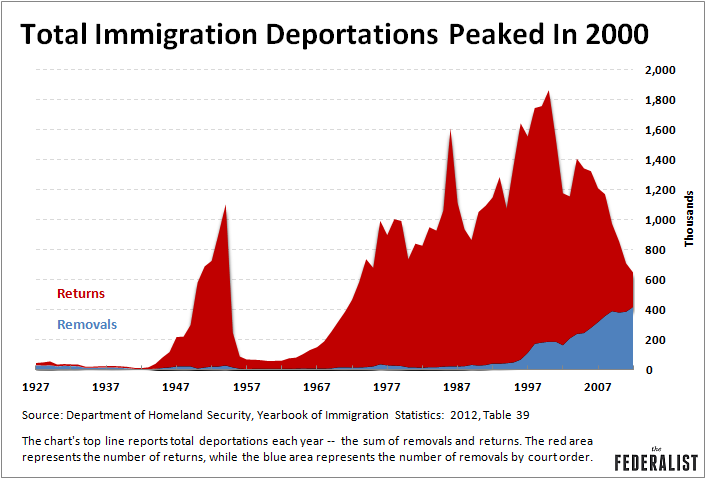
It turns out that explaining the news gets a lot easier once you decide to ignore news you don’t like. Take, for example, the latest entry on immigration from Vox. According to the ‘splainers at Vox, President Barack Obama is super tough on immigration. Don’t let all that amnesty talk fool you. How tough is he?
This tough:

Why, he’s set to become the biggest deporter of illegal immigrants in U.S. history! Except he’s not. Not by a longshot.
Vox writer Dara Lind didn’t just torture the data. Oh no. This was no simple waterboarding operation. The offending data was not forced to give a bogus confession. Nope. Lind straight up had the traitorous data disappeared.
In order to make her point that Obama was far more willing to deport illegal immigrants than his predecessor, she was forced to ignore and exclude 80 percent of all deportations under Bush. That’s right. How laughably wrong is Vox’s claim, which was obviously meant to make Obama look tough in order to make it easier to pass some type of immigration amnesty? Lind had to exclude 8.3 million deportations under Bush in order to con her readers into believing that the current president is totes the toughest ever on illegal immigration.
Here’s the complete picture of immigration deportation data going back nearly 90 years:

I’m no professional ‘splainer, but that looks to me like Obama is most definitely not the leading deporter of all time. In fact, total deportations in 2012 were the lowest they’d been since 1973.
Don’t take my word for it, though. Or the data’s word for it. Take the word of Simon Rosenberg, the president of the New Democrat Network (NDN), as reported yesterday afternoon by the Wall Street Journal:
NDN, in a memo being released Thursday, totaled the number of both “removals,” when individuals are deported from the country, and “returns,” when they are turned back at the border without a formal deportation process. Analyzed in this manner, the total number has fallen over the course of the Obama administration. That’s because while more people have been removed, returns have dropped dramatically. […] “Those who argue that Obama is deporter-in-chief, removing more people than anyone in history, are wrong,” said Simon Rosenberg, president of NDN.
According to the Department of Homeland Security, which tracks immigration enforcement actions such as deportations, there are two types of deportations: removals and returns. Removals require a court order, while returns don’t. Returns are the easiest to handle administratively. In most instances, an apprehended immigrant is given the opportunity to voluntarily return to his or or home country and avoid any other penalties. Removals are far more difficult, as they are the result of an extensive legal process which can result in an official judicial order to remove the immigrant from the U.S. Because of the significant costs of this process, as well as the time required to see it through to completion, additional penalties are attached.
The relative ease with which return deportations can be administered is one reason why they have been the overwhelmingly preferred method under every president of the modern era: not only do “returns” give apprehended immigrants the opportunity to enter legally in the future, the method also spares the courts from being gummed up with immigration cases. Under Carter, 97 percent of deportations were classified as “returns.” Under Reagan, it was 98 percent. For Bush I, it was just shy of 97 percent. For Clinton, it was 93 percent. And under George W. Bush, who oversaw over 10 million deportations between 2001 and 2008, returns comprised over 80 percent of all deportations. By way of contrast, that number was 50 percent through the end of Obama’s first term as president.
Unfortunately, you wouldn’t learn any of that context from Dara Lind’s fauxsplainer (a large part of explaining the news is deliberately omitting data that contradict your explanation). You would have no clue that returns comprised the vast majority of all deportations. You would have no clue that her new definition of what it means to be deported deliberately omitted 8.3 million deportations under Bush, 11.4 million under Clinton, 4 million under Bush I, and 8.1 million deportations under Reagan.
In order for Obama to suddenly be the biggest deporter in history, you have to sweep millions and millions of deportations under the rug and pretend they never happened. And then you have to deport the rug and broom so they won’t be around to snitch.
When I challenged her to explain the omission on Twitter, Lind responded by saying that a deportation isn’t a deportation unless it has “legal consequences.” Sure, they were deported, but they weren’t deported deported.
@seanmdav Because returns don't have legal consequences. They can't both be ineffectual "catch-and-release" & equal to deportations.
Dara Lind (@DLind) April 9, 2014
Here’s the thing: when your definition of “deportation” just so happens to exclude 90 percent of all federal deportations going back to 1927 (when the federal government first started tracking returns vs. removals), you’re doing it wrong. Even the uber-liberal Mother Jones of all places felt compelled to provide a balanced perspective on the current administration’s immigration enforcement regime. And Mother Jones even took the time to make and format their own charts, which, unlike those from Vox, included both the removal and return data series.
In her so-called explainer, Lind attempted to rationalize her decision to withhold highly relevant data by claiming that since you could theoretically deport the same “returned” person multiple times, it’s not a useful statistic. But the exact same could be said of an immigrant who was removed pursuant to a court order and nonetheless attempted to return to the U.S. Lind’s response to a simple question about data exclusion resembles an exercise in retroactive excuse-making more than it does a coherent rationale.
When you look at all of the available data, what becomes clear is not that Obama is super duper totally tough on immigration enforcement, but that he’s more than happy to avoid the simplest and most efficient forms of enforcement in favor of far messier methods that take far longer to be resolved. You might even look at the data and conclude that he’s gumming up the works on purpose to slow down the overall process, or that he’s deliberately refusing the easy, low-cost deportations in order to increase the pool of people who may qualify for the next amnesty. Or it could be that the dismal economy has significantly reduced the number of individuals who want to come to America in search of opportunity. But you won’t come close to any of those explanations if you’re never even given the opportunity to look at the data, which is of course why Lind refused to show it to you.
Now, with all that said, let’s give Lind the benefit of the doubt about the data and examine her overall point: Barack Obama is on pace to oversee more “removal” deportations than any other president in history. Is that a newsworthy point? Is it even mildly interesting?
Not really.
When George W. Bush left office, he was the top deporter in history using Lind’s standard of measurement. So was Bill Clinton. And so was George H. W. Bush. Once you take those facts into account — facts that were, once again, curiously absent from Lind’s piece — the factoid suddenly loses whatever meaning might have been attached to it in the first place.
The fact of the matter is that regardless of how you feel about immigration or amnesty or border enforcement or whatever issue happens to push your buttons, you should be honest and open about basic data. And if you’re going to pretend that you somehow have the authority or experience to fairly explain complicated policy topics to people, then you should actually be prepared to disclose all the data and explain everything. Not just the stuff that’s convenient. Not just the data that you happen to like, or the data that just so happen to agree with your politics, or the data that make it easier for some piece of legislation you like to become law.
“All the facts that are fit to fudge” should not be the modus operandi of an outfit that purports to tell you everything you need to know about everything under the sun. Whether to err on the side of full disclosure really shouldn’t be a tough question for America’s smartest thinkers.








